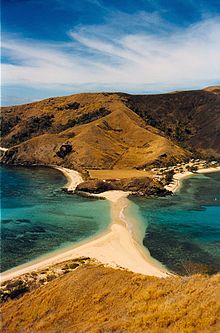Shoal
- "Sandbank" redirects here. For other uses of the word see Sandbank (disambiguation).


A shoal or sandbar (also called sandbank) is a somewhat linear landform within or extending into a body of water, typically composed of sand, silt or small pebbles. A bar is characteristically long and narrow (linear) and develops where a stream or ocean current promote deposition of granular material, resulting in localized shallowing (shoaling) of the water. Bars can appear in the sea, in a lake, or in a river. Alternatively a bar may separate a lake from the sea, as in the case of an ayre. They are typically composed of sand, although could be of any granular matter that the moving water has access to and is capable of shifting around (for example, soil, silt, gravel, cobble, shingle, or even boulders). The grain size of the material comprising a bar is related to the size of the waves or the strength of the currents moving the material, but the availability of material to be worked by waves and currents is also important.
The term bar can apply to landform features spanning a considerable range in size, from a length of a few meters in a small stream to marine depositions stretching for hundreds of kilometres along a coastline, often called barrier islands.
In a nautical sense, a bar is a shoal, similar to a reef: a shallow formation of (usually) sand that is a navigation or grounding hazard, with a depth of water of six fathoms or less. It therefore applies to a silt accumulation that shallows the entrance to or the course of a river or creek.
Sandbars and longshore bars


This bar forms (sometimes seaward of a trough) where the waves are breaking, because the breaking waves set up a shoreward current with a compensating counter-current along the bottom. Also known as a trough bar. Sand carried by the offshore moving bottom current is deposited where the current reaches the wave break (Bascom, 1980). Other longshore bars may lie further offshore, representing the break point of even larger waves, or the break point at low tide.
Harbour and river bars
A harbour or river bar is a sedimentary deposit formed at a harbour entrance or river mouth by the deposition of sediment or the action of waves on the sea floor or adjacent beaches. A bar can form a dangerous obstacle to shipping, preventing access to the river or harbour in unfavourable weather conditions or at some states of the tide. Where beaches are suitably mobile, or the river’s suspended and/or bed loads are large enough, wave action can build up a bar to completely block a river mouth, damming the river, preventing access for boats or shipping, and causing flooding in the lower reaches of the river. This situation will persist until the bar is eroded by the sea, or the dammed river develops sufficient head to break through the bar.
Shoals as geological units
In addition to longshore bars discussed above that are relatively small features of a beach, the term shoal can be applied to larger geological units that form off a coastline as part of the process of coastal erosion. These include spits and baymouth bars that form across the front of embayments and rias. A tombolo is a bar that forms an isthmus between an island or offshore rock and a mainland shore.
The largest of the geological units of this kind is a barrier island, such as occur along the East Coast of the United States, along the Gulf coast, along the southern coast of Belize and many other locations worldwide.
In places of re-entrance along a coastline (such as inlets, coves, rias, and bays), sediments carried by a longshore current will fall out where the current dissipates, forming a spit. An area of water isolated behind a large bar is called a lagoon. Over time, lagoons may silt up, becoming salt marshes.
In some cases shoals may be precursors to beach expansion and dunes formation, providing a source of windblown sediment to augment such beach or dunes landforms.[1]
As habitation sites
Since prehistoric times humans have chosen some shoals for site of habitation. In some early cases the locations provided easy access to exploit marine resources.[2] In modern times these sites are sometimes chosen for the water amenity or view, but many such locations are prone to storm damage. [3][4]
Federal laws
- Coastal Barrier Resources Act of 1982
See also
Line notes
- ^ Mirko Ballarini, Optical Dating of Quartz from Young Deposits, IOS Press, 2006 146 pages, ISBN 158603616
- ^ [C.Michael Hogan (2008) Morro Creek, ed. by A. Burnham http://www.megalithic.co.uk/article.php?sid=18502]
- ^ Dick Morris (2008) Fleeced
- ^ Jefferson Beale Browne (1912) Key West: The Old and the New, published by The Record company
This article needs additional citations for verification. (October 2007) |
References
- Bascom, W. 1980. Waves and Beaches. Anchor Press/Doubleday, Garden City, New York. 366 p.
